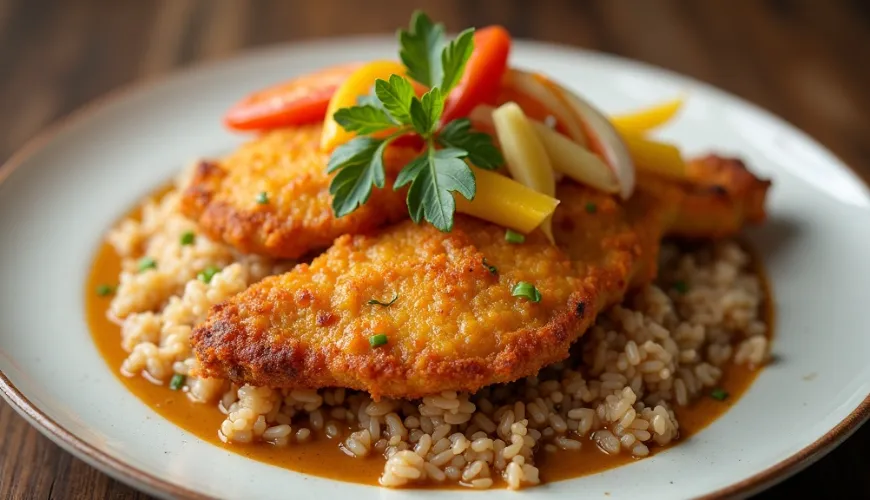
Discover the Magic of Japanese Katsu and Its Various Variants

The Magic of Japanese Fried Katsu - Why You'll Love This Crunchy Gem of Asian Cuisine
Few dishes can merge simplicity with deliciousness as perfectly as Japanese katsu. This crunchy fried cutlet, originally inspired by European cuisine, evolved in Japan during the 20th century into a true phenomenon. Today, it exists in dozens of variations, whether it's chicken katsu, pork tonkatsu, or plant-based alternatives. One of the most popular versions is katsu curry – a cutlet drenched in aromatic Japanese curry sauce.
How did this dish capture the hearts of food lovers worldwide? And why is it worth including katsu in home cooking – ideally in a healthier, more sustainable form?
What Exactly is Katsu?
The word "katsu" is a shortened version of the Japanese term "katsuretsu," which is a phonetic adaptation of the English "cutlet." In practice, it is a breaded and fried slice of meat, usually chicken or pork, coated in panko breadcrumbs and fried to a golden brown. When you say chicken katsu, most people envision a juicy cutlet with a delicately crunchy coating, served either with rice or as part of a sandwich.
The taste is heavily influenced by panko – Japanese breadcrumbs that are lighter and airier than traditional European ones. Thanks to it, katsu acquires its typical crunchy surface without being heavy or oily.
And why is katsu so popular? Perhaps because of its combination of the familiar and the exotic. It resembles a classic cutlet but with an Asian twist. It's a dish that's both familiar and new.
Katsu Curry - When Cutlet Meets Curry
One of the most popular versions is katsu curry – a fried cutlet served with rice and draped in Japanese curry sauce. Unlike Indian or Thai curry, Japanese curry has a milder, sweeter, and earthier flavor. The combination of crunchy meat and thick spiced sauce creates a perfect contrast of textures and flavors.
Japanese curry is not new in the Land of the Rising Sun. It arrived in Japan in the 19th century through the British Navy. Over time, it transformed into a distinct dish that today is a family classic on Japanese tables. The fusion of curry with katsu gave rise to one of the most valued "comfort food" dishes of the present day.
A popular version of katsu curry is chicken katsu curry, where tender chicken meat is used, which is less intense in flavor than pork but gains depth when combined with curry. In Japan and beyond, it's a standard dish available in restaurants, bistros, and even supermarkets as a ready meal.
A Story from the Czech Kitchen
Imagine a family living in Brno trying to revive experiences from a trip to Tokyo. The father decides to prepare chicken katsu with homemade curry sauce. Instead of traditional frying in a liter of oil, he uses an air fryer, the chicken meat comes from organic farming, and instead of white rice, he chooses whole grain. The children, who usually refuse spicy curry, fall in love with the dish. Not only does it taste like it came from a restaurant, but it's also made with health and the planet in mind.
This example shows that katsu doesn't have to be just a fried calorie bomb. On the contrary, it can be prepared in a healthier, more environmentally friendly version that doesn't lose any of its original flavor.
How to Prepare Katsu at Home – and More Sustainably
Although the original katsu is fried, there are alternatives that allow you to prepare this dish without excess fat. A popular method is using an oven or air fryer, which can create a crispy surface without the need to submerge the meat in oil. Another option is to replace the meat with a plant-based alternative, such as tofu or seitan. The flavor of the coating remains intact, but the environmental impact is significantly reduced.
The choice of ingredients also plays a role. Organic meat, organic vegetables, fair trade spices, and homemade curry paste can transform an ordinary dish into a responsible meal that tastes good and warms the soul. If rice from sustainable sources is used or replaced with another grain (e.g., millet or buckwheat), the result is a dish that is not only tasty but also a nutritional compromise.
Why Katsu is More Than Just a Cutlet
Katsu is not just another dish on the list. In Japan, it has symbolic meaning – it is often served to students before important exams because "katsu" also means "to win" or "to succeed." It’s a dish meant to give strength and encouragement. And this cultural depth gives katsu another dimension.
Moreover, it shows that food that is understandable and familiar, like a fried cutlet, can be a great gateway to a foreign culture. Katsu thus serves as a bridge between Europe and Asia, between traditional and modern.
"Food is the simplest way to understand another culture – and katsu is an ideal start," says Harumi Kurihara, a popular Japanese chef and cookbook author.
A Small Glossary of Katsu Specialties
To complete the overview, it's worth mentioning a few terms that are often associated with katsu:
- Tonkatsu – classic pork katsu, the most common form in Japan
- Torikatsu – chicken katsu, popular for its tenderness
- Katsu sando – sandwich with a slice of fried cutlet, popular as a "bento" meal
- Miso katsu – variant served with a thick miso sauce, typical for the Nagoya area
This shows that katsu is not only universal but also a highly locally adaptable dish.
When Katsu Meets Modern Trends
In the era of growing interest in sustainable food, even traditional dishes like katsu must adapt. And they do. Vegan versions are emerging using chickpea tofu, oyster mushrooms, or tempeh. Curry sauce can be made without meat stock, using vegetable broth and coconut milk. Ingredients like tamari, ume vinegar, or mirin add delicate Japanese tones while remaining plant-based.
Katsu can thus be part of a healthier lifestyle if both the preparation method and the choice of ingredients are modified. And this is where online stores focusing on eco-friendly foods and healthy nutrition come into play, allowing you to prepare authentic dishes without compromise.
While in the past katsu was synonymous with a fried dish, today it becomes a symbol of creativity in the kitchen – a dish that is unafraid of innovation but still remembers its roots. Whether you prepare it classically or in a vegan version, with curry or as a work sandwich, katsu offers exactly what today's kitchen needs – flavor, comprehensibility, and room for responsibility.

